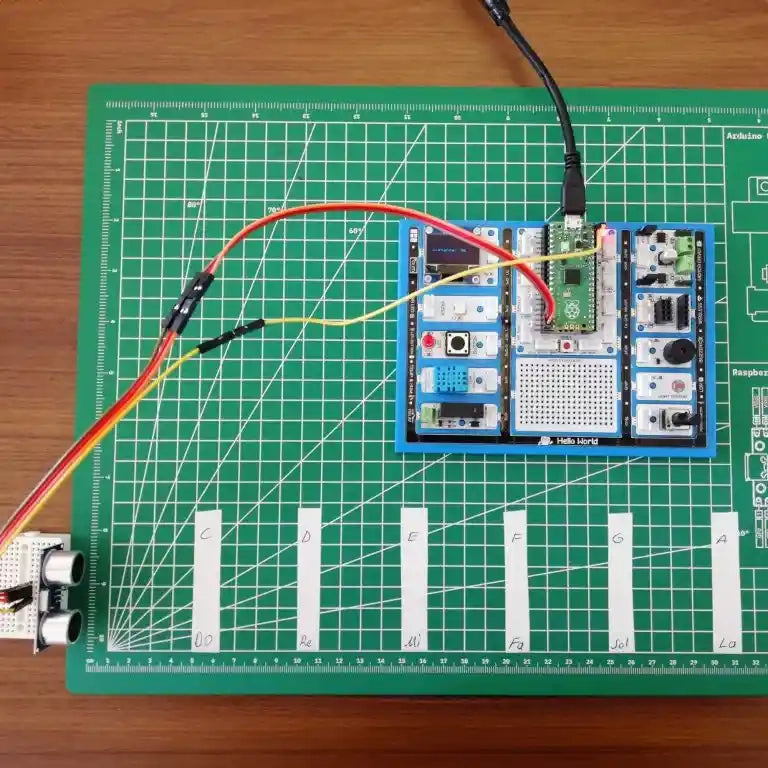With the development of electronic technology, musical instruments that are difficult to produce, expensive and producing high-quality sound have been digitized. Pianos are one of these instruments. Each key of digital pianos produces electrical signals at a different frequency. Thus, it can play 88 different notes from its speakers. Factors such as the delay time of the keys of digital instruments, the quality of the speaker, the resolution of the sound have appeared as the factors affecting the quality. In electric guitars, vibrations in strings are digitized instead of keys. On the other hand, In wind instruments, the notes played can be converted into electrical signals and recorded thanks to the high-resolution microphones plugged into the sound output. This development in electronic technology has facilitated access to high-cost musical instruments, music education has gained a wider variety and spread to a wider audience.
In this project we will make a simple piano that can play 7 notes with PicoBricks. The speaker of this piano will be the buzzer. The ultrasonic sensor will act as the keys of the piano.
Details and Algorithm
In this project, we will make a piano application using the HC-SR04 Ultrasonic distance sensor and the buzzer module on PicoBricks. We will make the buzzer play different notes according to the values coming from the distance sensor, and we will create melodies by moving our hand closer to the sensor and away from it. In addition, we will instantly print the distance and played note information on the OLED screen.
Components
1X PicoBricks
1X HC-SR04 Ultrasonic Sensor
Jumper Cables
Easy Connection Cables
Wiring Diagram

You can code and run Picobricks’ modules without wiring. If you are going to use the modules by separating them from the board, you should make the module connections with grove cables.
Construction Stages of the Project


MicroBlocks Codes of the PicoBricks

You can access the Microblocks codes of the project by dragging the image to the Microblocks Run tab or click the button.
MicroPython Codes of the PicoBricks
from machine import Pin, PWM, I2C
from utime import sleep
import utime
from picobricks import SSD1306_I2C
import _thread
#define the libraries
buzzer=PWM(Pin(20,Pin.OUT))
trigger = Pin(15, Pin.OUT)
echo = Pin(14, Pin.IN)
#define the input and Output pins
WIDTH = 128
HEIGHT = 64
#OLED screen settings
sda=machine.Pin(4)
scl=machine.Pin(5)
i2c=machine.I2C(0,sda=sda, scl=scl, freq=1000000)
#initialize digital pin 4 and 5 as an OUTPUT for OLED communication
oled = SSD1306_I2C(WIDTH, HEIGHT, i2c)
measure=0
def getDistance():
trigger.low()
utime.sleep_us(2)
trigger.high()
utime.sleep_us(5)
trigger.low()
while echo.value() == 0:
signaloff = utime.ticks_us()
while echo.value() == 1:
signalon = utime.ticks_us()
timepassed = signalon - signaloff
distance = (timepassed * 0.0343) / 2
return distance
#calculate distance
def airPiano():
while True:
global measure
if measure>5 and measure<11:
buzzer.duty_u16(4000)
buzzer.freq(262)
sleep(0.4)
elif measure>10 and measure<16:
buzzer.duty_u16(4000)
buzzer.freq(294)
sleep(0.4)
elif measure>15 and measure<21:
buzzer.duty_u16(4000)
buzzer.freq(330)
sleep(0.4)
elif measure>20 and measure<26:
buzzer.duty_u16(4000)
buzzer.freq(349)
sleep(0.4)
elif measure>25 and measure<31:
buzzer.duty_u16(4000)
buzzer.freq(392)
sleep(0.4)
elif measure>30 and measure<36:
buzzer.duty_u16(4000)
buzzer.freq(440)
sleep(0.4)
elif measure>35 and measure<41:
buzzer.duty_u16(4000)
buzzer.freq(494)
sleep(0.4)
else:
buzzer.duty_u16(0)
_thread.start_new_thread(airPiano, ())
#play the tone determined by the value of the distance sensor
while True:
measure=int(getDistance())
oled.text("Distance " + str(measure)+ " cm", 5,30)
oled.show()
sleep(0.01)
oled.fill(0)
oled.show()
#write the specified texts to the determined x and ye coordinates on the OLED screen
Arduino C Codes of the PicoBricks
#include <Wire.h>
#include "ACROBOTIC_SSD1306.h"
#include <NewPing.h>
#define TRIGGER_PIN 15
#define ECHO_PIN 14
#define MAX_DISTANCE 400
NewPing sonar(TRIGGER_PIN, ECHO_PIN, MAX_DISTANCE);
#define T_C 262
#define T_D 294
#define T_E 330
#define T_F 349
#define T_G 392
#define T_A 440
#define T_B 493
const int Buzzer = 20;
void setup() {
pinMode(Buzzer,OUTPUT);
Wire.begin();
oled.init();
oled.clearDisplay();
#if defined(__AVR_ATtiny85__) && (F_CPU == 16000000)
clock_prescale_set(clock_div_1);
#endif
}
void loop() {
delay(50);
int distance=sonar.ping_cm();
if(distance>5 & distance<11)
{
tone(Buzzer,T_C);
}
else if(distance>10 & distance<16)
{
tone(Buzzer,T_D);
}
else if(distance>15 & distance<21)
{
tone(Buzzer,T_E);
}
else if(distance>20 & distance<26)
{
tone(Buzzer,T_F);
}
else if(distance>25 & distance<31)
{
tone(Buzzer,T_G);
}
else if(distance>30 & distance<36)
{
tone(Buzzer,T_A);
}
else if(distance>35 & distance<41)
{
tone(Buzzer,T_B);
}
else
{
noTone(Buzzer);
}
oled.clearDisplay();
oled.setTextXY(2,4);
oled.putString("Distance: ");
oled.setTextXY(4,6);
String string_distance=String(distance);
oled.putString(string_distance);
oled.setTextXY(4,8);
oled.putString("cm");
}
GitHub Page





